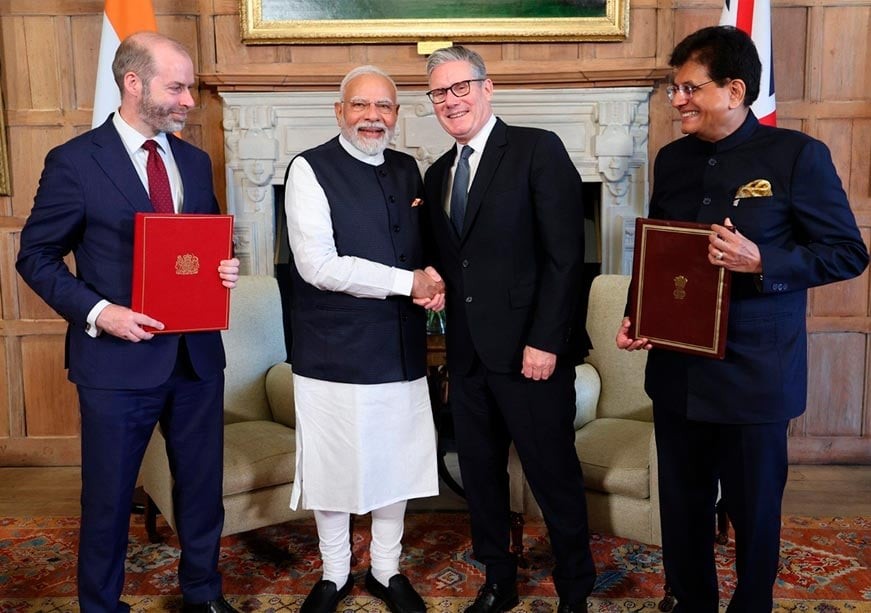-
CENTRES
Progammes & Centres
Location
By blending openness with calibrated safeguards, the UK-India FTA demonstrates how Adam Smith’s principles can be adapted to today’s complex global trade landscape

Image Source: Getty Images
Adam Smith’s doctrine, An Inquiry into the Nature and Causes of the Wealth of Nations, published in 1776, argued that free trade — which itself is rooted in the principle of natural liberty — increases national wealth by enlarging markets, enhancing the division of labour, and boosting productivity. He did not propose a total elimination of tariffs, but he did warn that protectionist policies were “a conspiracy against the public,” that they enriched a few at the expense of many. He posited that free trade permitted nations to specialise and barter, thereby bringing greater abundance to all, which has been theorised as the seminal idea of competitive advantage.
However, it appears that several countries have rejected this idea of free trade entirely, even at the risk of losing their competitive advantage. In recent times, many countries have moved away from the Smithian template in favour of protectionism.
The UK-India FTA is historic, not only for the two nations involved, but also because it acts as a compelling example for countries that are hesitant about open trade — a blueprint worthy of consideration when shaping their own future agreements.
Against this backdrop, the recently executed UK-India free trade agreement (FTA) arrives as a breath of fresh air on the global stage of trade relations.
On 24 July 2025, Indian Prime Minister Narendra Modi and UK Prime Minister Keir Starmer signed the India‑UK Comprehensive Economic and Trade Agreement (CETA), after more than three years of protracted negotiations. This is India’s first major FTA in over a decade, and the UK’s fourth since its controversial exit from the EU in 2020.
The UK-India FTA is historic, not only for the two nations involved, but also because it acts as a compelling example for countries that are hesitant about open trade — a blueprint worthy of consideration when shaping their own future agreements.
The India–UK relationship has been historically characterised by robust economic ties and trust, as evidenced by the status quo.
With upward-trending bilateral economic flows, UK-India trade in FY 2024 stood at US$21.3 billion; in FY 2025, it is pegged to reach US$23.1 billion. India currently maintains a trade surplus of US$5.9 billion with the UK. With the FTA enactment, both governments aim to expand bilateral trade to US$120 billion by 2030 in a move towards greater alignment. Marked by strong investment ties, during April 2000–March 2025, the UK was India’s sixth-largest foreign direct investor, with cumulative inflows of US$35.8 billion. This significant investment speaks to a stable economic partnership based on long-term capital commitments.
With the fruition of the long-awaited FTA, the two nations are poised to further deepen their economic, strategic, and cultural ties.
Whereas both countries are well placed to see meaningful economic gains from the FTA, India may benefit more relative to the size of existing trade relations. The UK’s Department for Business & Trade has projected a 25 percent increase in UK imports from India in the long run.
India’s Gains
Nearly 99 percent of India’s exports to the UK will face zero duty, including sectors such as textiles and clothing, leather, footwear, and gems and jewellery. The UK’s Department for Business & Trade projects UK imports from India in the long run to be worth approximately £9.8 billion in modelled 2040 trade volumes. India’s Commerce Minister Piyush Goyal anticipates duty-free access for an additional US$23 billion worth of exports.
The FTA will enable Indian businesses to grow in UK markets, especially its lucrative public procurement ecosystem. Indian firms will be granted non-discriminatory access to UK government contracts across high-value sectors such as infrastructure and healthcare. India’s domestic sectors — including agriculture, certain small businesses, and other sensitive areas — are sufficiently insulated to avoid severe disruption.
Meaningfully, despite its broad mandate, the FTA enables both countries to keep critical sectors sacred: in India’s case, agriculture and SMEs; and for the UK, its high-value manufacturing. The agreement harbours potential across key frontiers of innovation, such as clean technologies, artificial intelligence, and semiconductors, offering significant upside for both sides.
The UK will also see significant gains — not only in goods, as expected, but also through increased investments, R&D, and technology collaborations with India, a globally recognised and fast-growing partner.
UK’s Gains
UK exporters will gain duty‑free access for about 64 percent of their goods to India. Key sectors will see substantial tariff cuts — including alcoholic beverages, cosmetics, processed foods, and digital services — which are expected to yield £15.7 billion by 2024. In a dramatic case, Scotch whisky faces a drop from very high tariffs of 150 percent down to approximately 40 percent over a decade. Heavy tariffs on UK‑built cars to the tune of 100‑110 percent will decline to 10 percent under quota arrangements. Consumers in the UK will benefit from cheaper access to Indian textiles, jewellery, pharmaceuticals, and processed foods with the removal of tariffs.
The UK’s service industries in the finance, legal, and environmental sectors will gain access to India’s growing corporate market. UK companies meeting a 20 percent domestic-sourcing threshold will now be eligible to access India’s government procurement system, comprising approximately 40,000 tenders worth at least £38 billion a year. This will facilitate joint ventures, hybrid supply chains, and meaningful alignment between UK and Indian businesses.
Quantifiable Gains to the Bottom Line
This agreement goes beyond symbolism; it is poised to translate trade flows into measurable additions to the GDPs of both nations.
The UK government’s impact assessment report estimates a long‑term boost to UK GDP of £4.8 billion annually, accompanied by a £2.2 billion annual increase in wages compared to a no-deal scenario. The UK is also expected to attract approximately £6 billion in new investments and export opportunities, with the potential to generate over 2,200 new jobs across the country. For India, the same study projects a GDP rise of 0.06 percent, equivalent to roughly £5.1 billion per year, once the agreement is fully in effect. This analysis indicates that the India‑UK FTA represents quantifiable gains for both economies, with the potential to reap even more.
The UK-India Free Trade Agreement does not stand out merely for its lucrative size; it is also distinct for its multi-faceted approach. Beyond an agreement on goods, this deal strategically expands the template to include services, education, and technology.
Meaningfully, despite its broad mandate, the FTA enables both countries to keep critical sectors sacred: in India’s case, agriculture and SMEs; and for the UK, its high-value manufacturing. The agreement harbours potential across key frontiers of innovation, such as clean technologies, artificial intelligence, and semiconductors, offering significant upside for both sides.
The UK-India pact represents an innovative model for economic cooperation. It debunks the notion that nations must choose between tired globalisation and populist protectionism.
Having established a robust foundation in place, the agreement leaves room for both countries to explore further opportunities. While trade agreements seldom consider fiscal policy, this FTA presents an opportunity to design shared approaches. For example, streamlining tax policies to address double taxation and digital services taxation can unlock greater value. It is also worth evaluating benefits beyond the reduction of tariffs as envisioned by the current FTA. Fiscal policies that include shared innovation programmes, for instance, could generate greater long-term value for both nations.
The UK-India pact represents an innovative model for economic cooperation. It debunks the notion that nations must choose between tired globalisation and populist protectionism. The significance of the FTA goes beyond immediate economic gains for the two countries; it represents a refreshing and modern approach to smart trade, which acknowledges that countries need to forge sustainable ties while calibrating negotiations to their national priorities.
Meaningfully, the agreement provides the world a present-day reminder of Adam Smith’s economic principles — that mutually beneficial foreign trade can drive domestic prosperity. In an era where countries are erecting protectionist economic walls, the UK-India FTA represents a bilateral bridge.
Qaiser Shamim is a distinguished expert in fiscal policy, trade relations, and corporate governance.
The views expressed above belong to the author(s). ORF research and analyses now available on Telegram! Click here to access our curated content — blogs, longforms and interviews.

With over four decades at the forefront of public service and international corporate strategic advisory, Mr. Shamim is a distinguished expert in fiscal policy, trade ...
Read More +